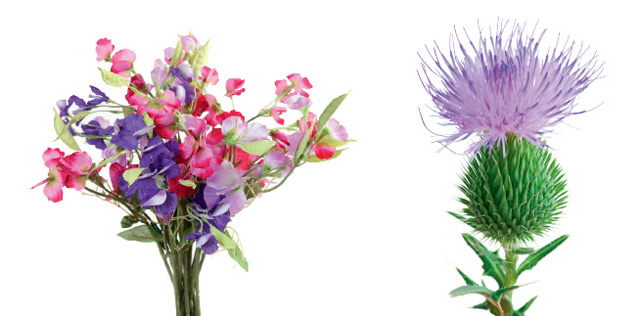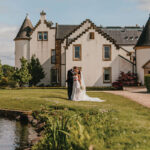Flowers will be a key element of your wedding, but if you don’t know a pomander from a posy, our garland glossary will set you straight
Words by Ann Russell
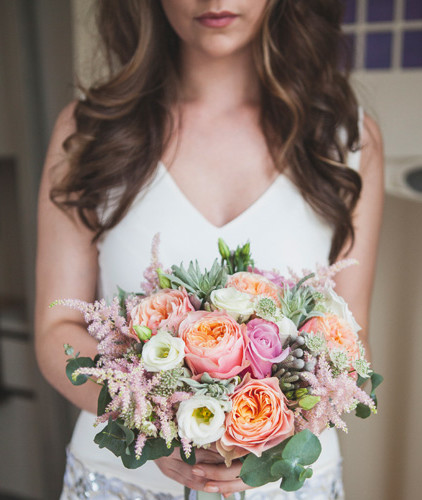
Wedding Flowers by Susan,
www.weddingflowersbysusan.co.uk
Photo: Tandem Photo,
www.tandemphoto.co.uk
Much like brides, flowers come in different shapes and sizes. From long and lean calla lilies to bright and bold gerberas, there’s a bridal bloom out there to suit you. Finding your way through a jungle of stems can be tricky, though, so we’ve enlisted the expertise of three florists to demystify the process of choosing flowers. By the end of this article, you should know your peonies from your anemones, and have a much clearer idea of what all that blooming technical jargon means!
Crescent
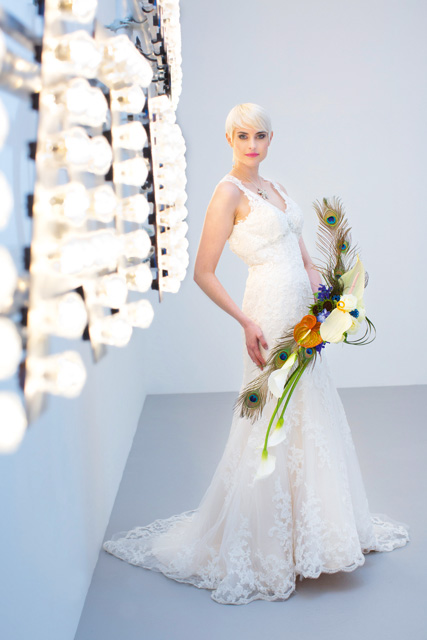

avalanche roses, lily grass and wire work, Nikki’s Fleurs
Adventurous brides looking for a show-stopping arrangement will love this unusual hand-held bouquet. Forming a structural U-shape, the crescent is compact in the middle and free-flowing at each side. The shape is made using flowers with prominent silhouettes (such as orchids) to intertwine and form a soft arch, with the centrepiece held together around a thin handle. It looks wonderfully dramatic.
Posy
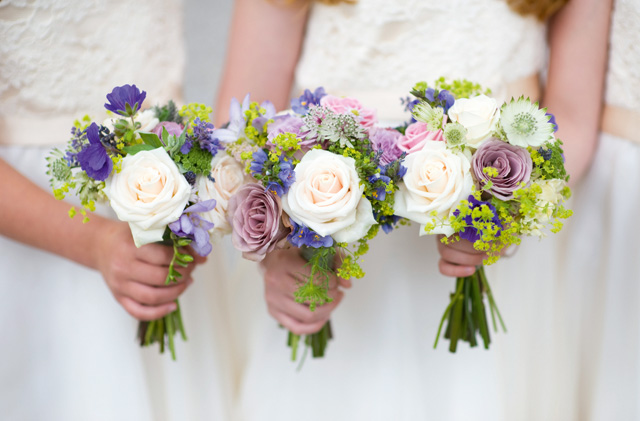

Smaller than a standard hand-tied bouquet but similar in design, posies often include small-headed roses or delicate grape hyacinths. For contemporary styling, use just one flower type in your posy – a striking rose, say – and frame it with large leaves. “In summer I’d recommend a posy of sunflowers or cornflowers for their beautiful colours, while in the spring, bulbs like muscari and freesias work well together,” suggests Sandra Andrews of Sanpado Florist (sanpadoflorist.co.uk). “We like to weave smaller flowers into a posy of hydrangeas in the autumn to highlight their full white, blue and purple blooms; and in the winter there’s a range of rich berries and greenery such as holly and ivy.”
Cascade or Shower
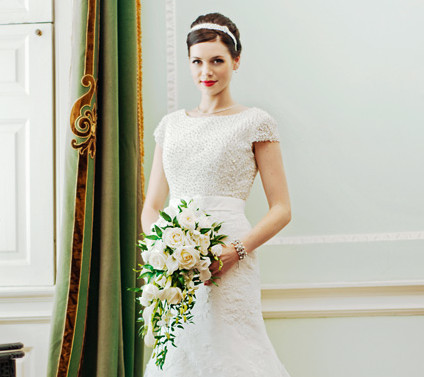

Imagine an overflowing, descending flow of flowers secured by a hand-held plastic base. Cascade bouquets, also known as showers or teardrops, were in high demand in the 1920s and ’30s, when extravagant arrangements were an indication of wealth. Princess Diana’s opulent wedding cascade revived the trend for stylised flowers in the 1980s, and they’ve been a popular choice ever since. “Shower bouquets flow in a flattering stream from the bride’s hand down her dress like a waterfall,” explains Sandra Andrews at Sanpado Florist. “The flowers are tightly secured onto a handle so they’ll last throughout the day and maintain their shape. Cascades tend to involve more work than a hand-tied bouquet, which means they’re more expensive,” she says.
Pomander
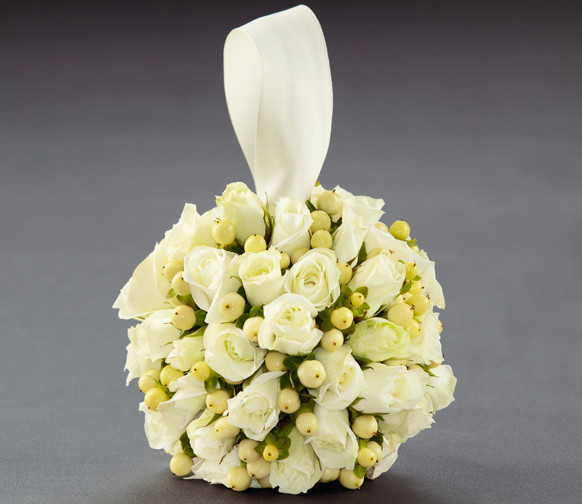

This bloom-covered ball, suspended from a ribbon, is a light, manageable option for flower girls. “We soak a round 12cm oasis in water then insert stems of greenery before placing a selection of flowers strategically around the ball,” explains Hazel of Hazel’s Flower House (hazelsflowerhouse.com).
Baskets filled with flowers or rose petals are another option for the wedding party. “Arrangements in baskets offer an alternative to standard bridesmaid bouquets and often last a little longer. Eucalyptus works well for foliage alongside calla lilies or roses in a shade that complements the bridesmaid dresses,” suggests Julie Johnstone of Heaven Scent Events (heavenscent-events.co.uk).
Hand-tied
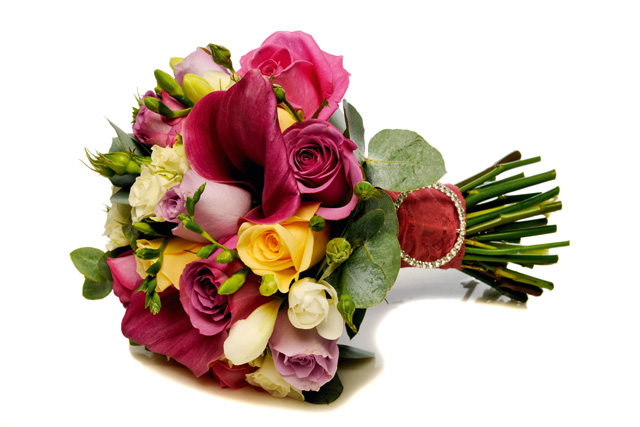

This versatile hand-tied bouquet is a firm favourite with brides and is perhaps the simplest shape of the bunch. Whether you prefer a ‘compact’ bouquet without greenery or a ‘loose’ bouquet with interspersed foliage, this circular gathering of blooms is simply tied together with wire or floral tape and finished with ribbon. “Hand-tied bouquets are the market leaders and the most requested shape for weddings,” says Sandra. “Groups of flowers are tied together in a spiral and secured in a specific way so that the stems don’t break. We create small versions of our standard bouquets for flower girls and oversized options for centrepieces that include lisianthus, freesias and bouvardia.”
Styles of centerpiece
Champagne vases or trumpets
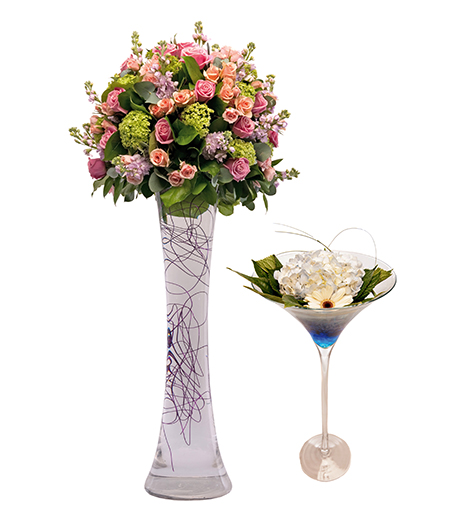

Flowers in Thyme
Tall trumpet centrepieces give an immediate wow factor as guests enter the room. With a wider top and a narrow base, the flowers tend to cascade over the sides of the vase for a dramatic look. “Tall vases add height and work well in large rooms with high ceilings. We fill clear glass vases with gel balls and typically decorate them using a posy plate filled with calla lilies and white roses,” says Julie of Heaven Scent Events. But whether you want a towering centrepiece or a mini display, it’s crucial that your guests can talk to one another across the table, so avoid oversized arrangements that will obstruct their view.
Candelabra
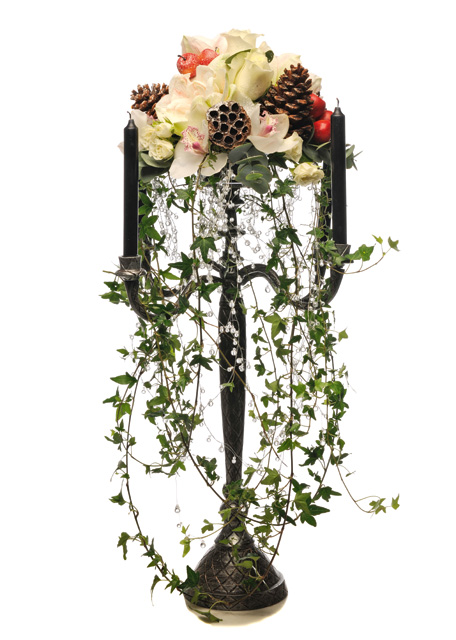

apples, acorns and trailing ivy, Ann Baff Flowers
A foolproof classic that is decorated with flowers at the neck and greenery or ribbons around the base of the vessel. This multi-armed centrepiece brings a sense of occasion to your tables and is cost-effective because the blooms are used to enhance the candelabra rather than being the main focus themselves. “We often recommend candelabras for brides on a budget because we can arrange a small group of flowers in the centre of the stand or wrap layers of ivy around the candles and candlesticks to keep things simple,” explains Hazel of Hazel’s Flower House.
Single Blooms
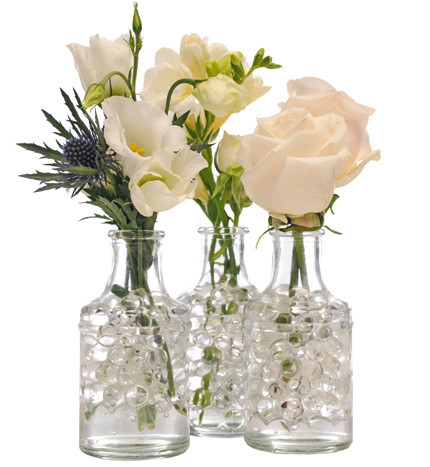

Fancy yourself as a creative bride? Experiment with this free-spirited centrepiece. As a simple way to add character to your reception décor, flowers are grouped together in a series of clear or colourful vases to give a handpicked feel. Play around with vases, jugs, buckets and jars and add tealights to complete the look. Woodland flowers in a simple jar on hessian table runners can be as effective as tall blooms in crystal vases. Whether you’re a minimalist or love lashings of bling, a collection of single blooms can achieve the impact you desire without feeling overdone.
Fish Bowl
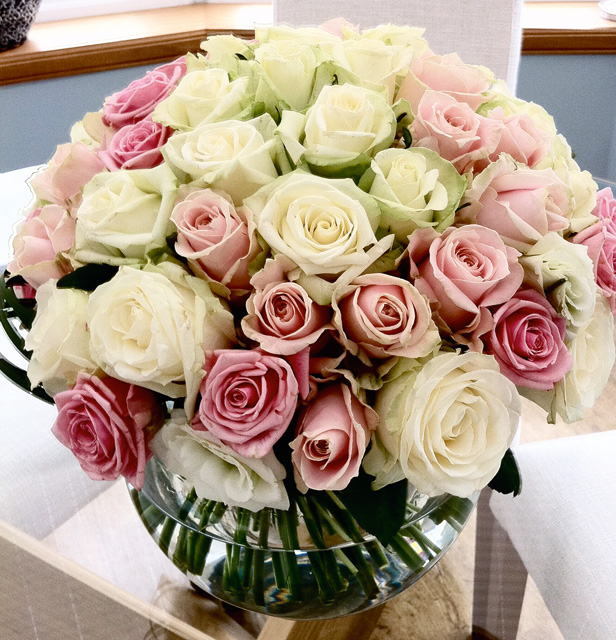

This self-explanatory rounded glass centrepiece features a single flower or a trail of blooms clustered within it. “A single gerbera or chrysanthemum bloom can look effective in a glass bowl, with sand, water or beads at the base. It’s a budget-friendly way to create a simple centrepiece because it can look fantastic with just one bloom,” Sandra explains.
Birdcages
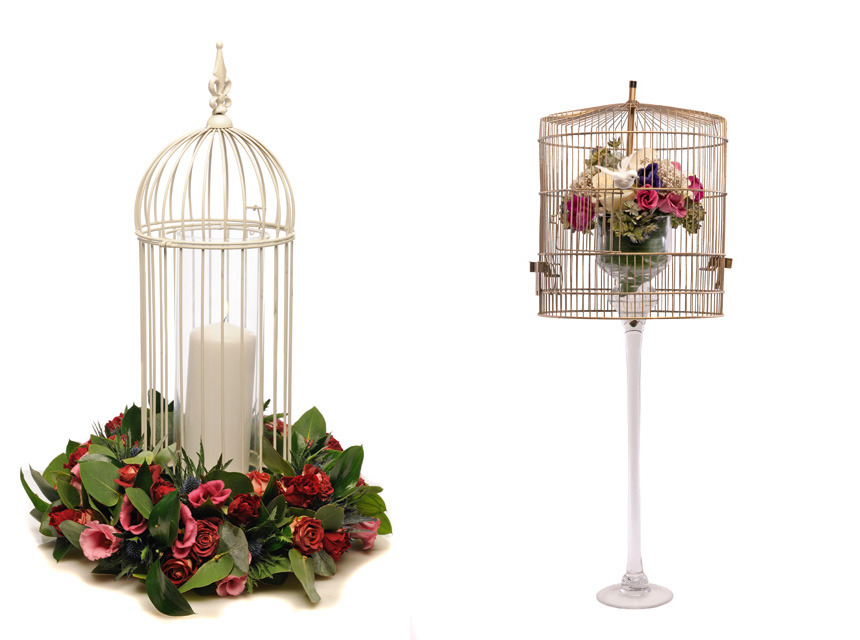

Nikki’s Fleurs and Birdcage display of pink
lisianthus, dried rice
flowers, dried hydrangeas,
Avalanche roses, calla lilies, anemones and pearl detailing, The Black Orchid
The new kid on the block, birdcages are part of the current trend for vintage-style weddings. These unlikely props have transformed the centrepiece scene and given florists the chance to create less formal displays that are reminiscent of country gardens. Lending themselves well to a rustic wedding theme, birdcages can be draped with flowers for a soft, unstructured look. “To create delicate vintage centrepieces, we wrap wired flowers and ivy around the outside of the birdcage and use an oasis in the base filled with small buds such as freesias,” Julie explains.
Types of flowers
Anemone: Delightfully delicate spring bloom in a variety of colours, with a stiff green stem. The petals are reminis-cent of a poppies, as are their dramatic black centres. Often used for ‘blending’, since the petals and centres grow in different colours.
Calla Lily: An elegant flower often displayed in a tall glass vase because of its thick, dramatic stem. Available in a range of colours, from purple to orange. Its defining feature is its shape – it looks effortlessly elegant when displayed on its own.
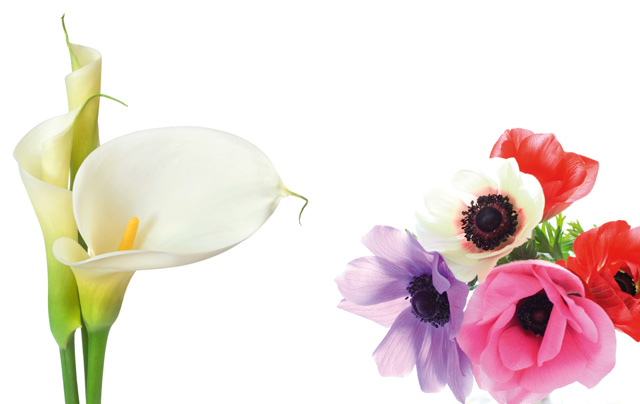

Delphinium: Widely used in larger arrangements, such as ceremony displays, this popular blue bloom also comes in white and peach varieties. Its individual florets can be removed and wire-wrapped for inexpensive buttonhole and corsage accent flowers. If royal blue is your primary colour scheme, the delphinium is your bloom, as its rich electric blue is truly unique.
Gerbera: This popular daisy-like flower comes in a range of colours. Part of the sunflower family, it has similarly dramatic, bright petals and a dark centre. “Gerberas look beautiful in bridal bouquets but don’t mix them with roses as the wide petals will look overpowering. Pair them instead with light foliage and let their pretty colours do the talking,” advises Julie.
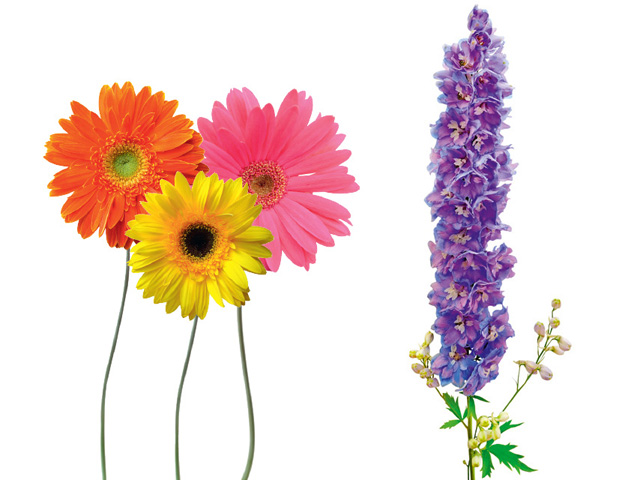

Hydrangea: A big bloom with lots of impact. Just a few bunches of hydrangeas together can form a dramatic centrepiece. Hydrangeas bloom profusely in summer, making them a good, inexpensive flower for weddings in June, July and August. There are over 75 varieties, and they come in shades of white, blue, purple and pink, so there is plenty of choice. Their light, chiffon-esque petals will move gently in the breeze and complement your wedding gown perfectly.
Lily of the valley: This beautifully scented white flower is only used in the most luxurious bouquets – no wonder it is a favourite of royal brides. “Lily of the valley is difficult to work with because it’s so incredibly expensive – a full bouquet would cost around £600, which isn’t manageable for most brides,” says Sandra. “Freesias and hyacinths are a more affordable alternative – they have a lovely perfume and look just as pretty.”
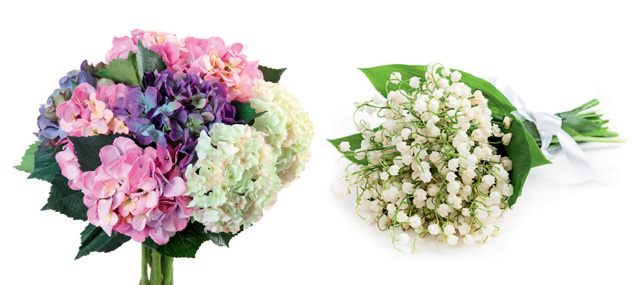

Peony: This soft, feminine flower has layers of delicate ruffles that echo the folds of a tulle wedding gown. Thanks to their large open heads, a collection of five or six is enough to produce a sizable bouquet. They work best in hand-tied bouquets alongside ranunculus and roses in a single-coloured arrangement that showcases their beautiful texture.
Rose: “Roses continue to be a classic choice because of their natural beauty and huge colour range. Brides can easily match their theme to an exact shade of rose. As it stands, turquoise and teal are the only shades we can’t source,” says Sandra.
Julie agrees: “Most brides request roses because they have a clear vision of how they look in a bouquet or centrepiece. We mostly use white and cream roses on their own in a bouquet rather than combining them with other flowers.”
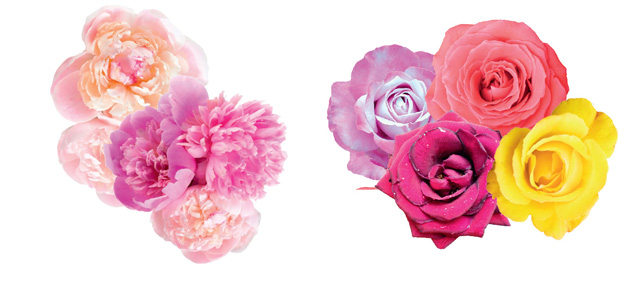

Sweet Pea: Appearing in late spring, these popular flowers are relatively hardy despite their delicate appearance. “We buy most of our flowers direct from growers in Holland but our sweetpeas come from a supplier in Scotland who cultivates them in a greenhouse. They have a wonderful free-flowing quality and a soft shape that really suits wedding bouquets,” says Hazel.
Thistle: “Thistles are known for their longevity compared to other flowers. And while heather is seasonal, thistles are available all year round,” explains Sandra. “Thistles are in high demand for buttonholes, as are roses highlighted with berries in the winter. Thistles are a traditional Scottish emblem that both the bride and groom can wear with pride,” she concludes.
